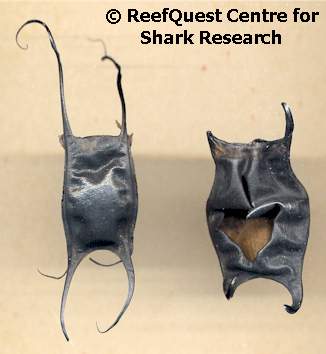Elasmobranch Reproductive Modes
Shark reproduction can be divided into seven modes based on the method of embryonic nutrition. The system of reproductive modes used here is slightly modified from Dulvey & Reynolds (1997). These are defined as follows:
|
|
Extended Oviparity – also termed “single oviparity”; paired eggs are laid, one from each oviduct; embryos derive nourishment solely from yolk in external yolk sac and undergo most of their development outside the mother’s body; the egg membrane is sclerotinized to form a collagenous, sulphur-rich case that often has antifouling properties. Found in bullhead sharks (Heterodontiformes), most catsharks (Scyliorhinidae), and skates (Rajiformes).
Retained Oviparity – also termed “multiple oviparity”; several egg cases accumulate in each oviduct and are retained, unhatched, up to several months before being laid in a collagenous case, resulting in embryos from the same clutch at slightly different stages of development. embryos derive nourishment solely from yolk in external yolk sac and undergo much of their development outside the mother’s body.
NOTE: in some species, eggs may be retained until development is complete, whereupon hatching and parturition coincide, e.g. nurse sharks (Ginglymostomatidae) and some catsharks (Halaelurus spp.)
Leicithotrophic Viviparity – also termed “ovoviviparity”; similar to retained oviparity; except eggs are packaged in thin cases and retained until development is complete, whereupon parturition occurs; embryos derive nourishment solely from yolk supply in external yolk sac. Found in Frilled Shark (Chlamydoselachiformes), cow sharks (Hexanchiformes), bramble sharks (Echinorhiniformes), dogfishes (Squaliformes), angel sharks (Squatiniformes), sawsharks (Pristiophoriformes), some catsharks (Galeus spp.), shovelnosed guitarfish (Rhynchobatiformes), Bowmouth Guitarfish (Rhiniformes), sawfishes (Pristidae), electric rays (Torpediniformes), and stingrays and eagle rays (Myliobatiformes).
Matritrophic Viviparity with Oophagy – embryos feed initially on yolk in external yolk sac; after yolk sac is absorbed, embryos feed on unfertilised ova produced and shed by their mother. Found in all mackerel sharks (Lamniformes) except the Sandtiger (Carcharias taurus).
|
|
Matritrophic Viviparity with Adelphophagy – embryos feed initially on yolk in external yolk sac, then unfertilised ova produced and shed by their mother, then cannibalize siblings, Found in the Sandtiger (Carcharias taurus).
Matritrophic Viviparity with Oophagy and Histotroph – embryos feed initially on yolk in external yolksac, then unfertilised ova produced and shed by their mother, these ova are consumed by embryos to replenish the external yolk sac; vilified embryonic surfaces indicate absorption of histotroph (“uterine milk”). Found in false catsharks (Pseudotriakidae).
Matritrophic Viviparity with Placenta – also termed “viviparity” or “placental viviparity”; embryos feed initially on yolk in external yolk sac, then depleted yolk sac interdigitates with endometrial tissues (lining of mother’s uterus) to form a direct placental blood vessel link to mother; some species may also supplement placental nutrition with histotroph; vilified surfaces on the embryo or placental stalk (“appendiculae”) allow absorption of histotroph in addition to nutrients transferred via the placental link. Found, with some exceptions, in smoothhounds (Triakidae), weasel sharks (Hemigaleidae), whaler sharks (Carcharhinidae), and hammerhead sharks (Sphyrnidae)


